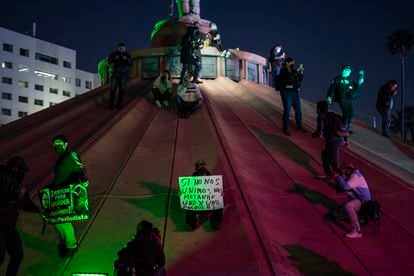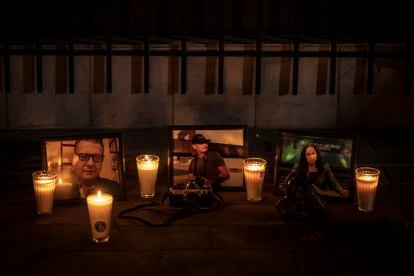Journalists and citizens from all over Mexico have come out this Tuesday to demonstrate in more than thirty cities in rejection of the violence suffered by the union. Mexico is the most dangerous country in the world to practice the trade, with dozens of murders every year and hundreds of assaults. Impunity reigns. Every year, about 90% of crimes are lost in the files of prosecutors. Attacks on freedom of expression are no exception.
In Mexico City, half a thousand people have gathered in front of the door of the Ministry of the Interior, the nerve center of federal power. Groups of displaced reporters and professionals from other states have hung a poster at the entrance, demanding justice for the murdered comrades, particularly for the last three. In the first weeks of January, criminals have killed reporter Lourdes Maldonado and photojournalist Margarito Martínez, in Tijuana, and José Luis Gamboa, in Veracruz.
“I come in solidarity with the union. It is unsustainable”, said the lawyer Frida Romay in front of the door of the Interior. “This government calls itself leftist, but with its actions it shows us that it is not. We must take care of the truth”, he added. Tijuana-based journalist Laura Sánchez Ley exclaimed: “We have to press for the specialized federal prosecutor’s office to attract the murders of reporters, so that the journalist protection mechanism of the Government pays attention to the cases.”
On the steps of the office entrance, reporters took the microphone in procession, a cathartic exercise on the hardships of the job, especially at the local level, in towns and medium-sized cities where mafias poison public life. They were all claims to a government that they feel is far away. “Where is Encinas?” said one, referring to the Undersecretary of the Interior in charge of ensuring human rights in the country. No government representative has appeared at the protest.
Summoned to the race after the last murder, that of Lourdes Maldonado on Sunday in Tijuana, the marches have attracted attendees throughout the Mexican territory. In Tijuana, but also in Veracruz, cursed geography for the profession in the years of the last PRI government (2012-2018), Chihuahua, home of the reporter Miroslava Breach, murdered in 2017, or Culiacán, in whose streets hitmen killed Javier Valdez that same year. A geography of indignation, but also of wound.
The figures are depressing. The three fatal attacks on reporters this year and the nine in 2021 are just the tip of the iceberg. iceberg, the echo of a cry that has been sounding for more than two decades in the country. According to the Committee to Protect Journalists (CPJ), at least 138 reporters have been killed in Mexico since 1992, the year it began documenting attacks on the press. For the local chapter of the Article 19 organization, the count is 145, only since 2000.
The difference between figures responds to the ability of the Mexican authorities to establish links between the attacks and the journalistic work of the victims. That is, if there is confirmation of the reason for the attacks and they point to the work of the reporters or not. In any case, the numbers are extremely high and show the inability of the Administration, overwhelmed by a wave of violence that has left more than 30,000 murders in the country in each of the last four years.
In Tijuana
The march in Tijuana, the epicenter of the horror of the violence against the press these days, has advanced in silence towards the headquarters of the State Prosecutor’s Office. Unlike the rest of the protests, more than a hundred journalists —most of them— walked silently along Paseo de Los Héroes with the last rays of sunlight in this border city. A few kilometers from here, the roundabout of Las Tijeras, and in less than a week, those who walk have been murdered in cold blood and at the doors of their houses, two companions: Margarito Martínez and Lourdes Maldonado.

“I didn’t expect it to hurt so much. I can’t, really…”, commented a journalist with glassy eyes to the director of the legendary Weekly ZETA, Adele Navarro. “We hadn’t recovered from Margarito’s death, we were assuming it when they killed us in Lourdes,” adds the president of the Yo Sí Soy Periodista group and adviser to the state system of the Protection Mechanism for journalists and activists, a government tool that must guarantee their safety. , but that did not prevent Maldonado from being shot in the face. Margarito had requested it and due to a bureaucratic issue it had not been granted: another bullet to the skull.
“Two colleagues who said they feared for their lives. Who asked for help, have been killed. We are here to ask for justice, that is why we are here. Also to pay tribute, although we know that the best tribute is precisely to demand justice,” said José Ibarra, from the media Siempre en la Noticia, upon arriving at the doors of the Prosecutor’s Office.
“We are leaving our newsrooms and stopping covering events due to the murder of our colleagues,” said Aline Corpus, a reporter for Reform, before reading the statement to which all the national media have subscribed and which has been shared in the rest of the marches in the rest of the country. Like Corpus, a string of colleagues took the microphone to denounce a fact that has left the union in the city wounded: “We see with anger and indignation that crimes in the country continue to go unpunished. Killing a journalist in Mexico is like killing no one. Far from a serious investigation, the figures are increasing. The presence of organized crime in collusion with governments has allowed silence and puts our work at risk”, added Inés García, from Punto Norte. Mariné Zavala, from Telemundo, has issued a warning: “We have to reconsider how safe we are to do our job.”
Another of the important points that put the union in check has also been denounced this afternoon in Tijuana. “A photographer like Margarito Martínez earned approximately 6,000 pesos a month [unos 300 dólares] for days that never ended”, criticized García.
With the pain in their shoulders and in their notebooks and under their masks, with fear stuck in their throats, they walked towards the Prosecutor’s Office. Some banners chanted what the protesters had agreed to silence during the journey: “A country that kills journalists is not a safe country.” Candles, white roses and photos of Margarito Martínez and Lourdes Maldonado paraded on the way to the prosecutor’s office, amid the sound of flashes and barking dogs. Some walked for a while and then ran to the front to take photos; others wrote the chronicle of the day on their cell phones with one hand, while holding a banner under their arm. Most of them continued to do their jobs while protesting to demand that their lives not be at stake in return.
The daily grind in Tijuana was normal. With traffic waiting to get to his house as the demonstration circulated. No car, however, dared to honk its horn in complaint mode. This demonstration was a street funeral. And so, in mourning, together, thinking that anyone could be next, they said goodbye to two colleagues this Tuesday. Before ending the act, they raised their voices furiously: “Strength, comrades”, “Long live Lourdes and Margarito!”, “Long live the free press!”.
Juarez City
Slowly, with chalk and a camera around his neck, a photographer from Ciudad Juárez wrote the word justice. He scribbled it on the cement floor in front of the three photos of his dead colleagues while other colleagues took photos of him and shined their spotlights on him. There were 50 of them and no one spoke, no one was used to being on the other side of the note. They silently lit the candles and put up some signs. The protest was in the Plaza del Periodista, in the already empty center of the border city at nightfall, next to the plaques that recall the names of the reporters who have died over the years.

In a small presentation, the photojournalist Alicia Hernández dared to say that this mobilization arises from the weariness. Three deaths in three weeks is too much even for a union that puts up with pressure and threats on a daily basis. The one that Maldonado, Martínez and Gamboa suffered is a violence that Juarez knows well. Driver Arturo Alba Medina was murdered in October 2020 after leaving a program in which he had denounced corruption within the police. He was shot to death while driving. It was the sixth in the border city since 2000, 23 in the State of Chihuahua.
Given that, the only thing left was solidarity between colleagues, says Hernández. Journalists covering journalists. “Compañerismo”, called Gustavo Calzada, who is 23 years old and is studying Journalism at the University of Ciudad Juárez. He says while holding tightly to the photograph of Gamboa that he does not feel afraid, but he does feel strange, that no one other than the companions of the murdered reporters had come to the protest. “Then we will have to do it ourselves.”
The Prosecutor’s Office and the mechanism
Since Vicente Fox (2000-2006), Mexico has had governments of three different parties and none has dealt with the problem of violence, except for attacks against journalists. First the PAN, with Fox himself and Felipe Calderón (2006-2012), then the PRI, with Enrique Peña Nieto (2012-2018) and now Andrés Manuel López Obrador, with Morena (2018-2024), the attacks follow one another with outrageous regularity. All governments have dealt with critical moments, but none so serious as to generate a paradigm shift.
It has not been for lack of protest or outrage, the last batch in 2017, with the practically consecutive murders of Breach and Valdez, both attacked for their journalistic work. The confirmation of the mobile responds here to the work of the Specialized Prosecutor’s Office for Crimes against Freedom of Expression, FEADLE, an exception in reality. Most of the murders or attacks against journalists carried out by FEADLE go unpunished.

Upon the death of Breach and Valdez, a wave of protests, supported by groups of foreign journalists and international organizations, drew a promise of change from the Executive, then led by Peña Nieto. The president promised to strengthen the two instruments available to the State to protect journalists, the FEADLE and the mechanism for the protection of journalists and activists of the Ministry of the Interior, which has an annual budget of close to 500 million pesos and around 1,500 beneficiaries.
With three murders in three weeks, suspicion hangs over both tools again. The lack of a review protocol at the highest level of the federal government or the Attorney General’s Office and the weak response of the administration to the attacks, haggled with the usual lightness of condolences, invite us to think of few changes and a future of new protests, new aggressions. An endless cycle.
subscribe here to newsletter of EL PAÍS Mexico and receive all the informative keys of the news of this country
elpais.com
Eddie is an Australian news reporter with over 9 years in the industry and has published on Forbes and tech crunch.